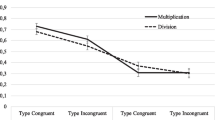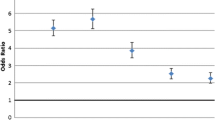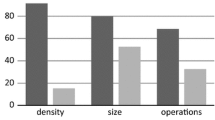Abstract
This study investigates the hypothesis that there is a natural number bias that influences how students understand the effects of arithmetical operations involving both Arabic numerals and numbers that are represented by symbols for missing numbers. It also investigates whether this bias correlates with other aspects of students’ understanding of the number concept beyond natural numbers. Natural number bias has been characterized as the interference of natural number knowledge in reasoning about non-natural numbers. Quantitative data is presented showing that in the case of operations between numbers and missing numbers this bias acts in two main ways. First, it shapes students’ anticipations about the expected outcome of each operation, that is, that the result of addition or multiplication “must” be bigger than the initial numbers and the result of subtraction or division “must” be smaller. Second, it causes students to think that missing numbers stand mostly for natural numbers; this tendency would lead students to make decisions about the general results of operations by substituting only natural numbers for the missing number symbols. It is argued that knowledge about operations between natural numbers needs to be inhibited for students to overcome the natural number bias and to reason with numbers beyond the scope of natural numbers.
Similar content being viewed by others
References
Babai, R., Shalev, E., & Stavy, R. (2015). A warning intervention improves students’ ability to overcome intuitive interference. ZDM Mathematics Education, 47(5) (this issue).
Bell, A., Swan, M., & Taylor, G. (1981). Choice of operation in verbal problems with decimal numbers. Educational Studies in Mathematics, 12, 399–420. doi:10.1007/BF00308139.
Christou, K. P. (2012). Helping students remedy the phenomenal sign bias: the case of a refutational lecture. In C. Prachalias (Ed.), Proceedings of the 8th International Conference on Education (pp. 643–648). Greece: Samos.
Christou, K. P. The dual aspect of natural numbers bias in arithmetic operations (submitted).
Christou, K. P., & Vosniadou, S. (2005). How students interpret literal symbols in algebra: a conceptual change approach. In B. G. Bara, L. Barsalou, & M. Bucciarelli (Eds.), XXVII Annual Conference of the Cognitive Science Society (pp. 453–458). Italy: Stresa.
Christou, K. P., & Vosniadou, S. (2012). What kinds of numbers do students assign to literal symbols? Aspects of the transition from arithmetic to algebra. Mathematical Thinking and Learning, 14(1), 1–27. doi:10.1080/10986065.2012.625074.
Davis, R. B. (1984). Learning mathematics: the cognitive science approach to mathematics education. London: Croom Helm.
De Corte, E., Verschaffel, L., & Pauwels, A. (1990). Influence of the semantic structure of word problems on second graders’ eye movements. Journal of Educational Psychology, 82(2), 359–365. doi:10.1037/0022-0663.82.2.359.
DeWolf, M., & Vosniadou, S. (2014). The representation of fraction magnitudes and the whole number bias reconsidered. Learning and Instruction, Advance online publication.,. doi:10.1016/j.learninstruc.2014.07.002.
Fischbein, E. (1990). Intuition and information processing in mathematical activity. International Journal of Educational Research, 14(1), 31–50. doi:10.1016/0883-0355(90)90015-Z.
Fischbein, E., Deri, M., Nello, M., & Marino, M. (1985). The role of implicit models in solving problems in multiplication and division. Journal of Research in Mathematics Education, 16, 3–17. doi:10.2307/748969.
Gelman, R. (2000). The epigenesis of mathematical thinking. Journal of Applied Developmental Psychology, 21, 27–37. doi:10.1016/S0193-3973(99)00048-9.
Graeber, A. O., Tirosh, D., & Glover, R. (1989). Preservice teachers’ misconceptions in solving verbal problems in multiplication and division. Journal for Research in Mathematics Education, 20, 95–102. doi:10.2307/749100.
Green, M., Piel, J. A., & Flowers, C. (2008). Reversing education majors’ arithmetic misconceptions with short-term instruction using manipulatives. The Journal of Educational Research, 101(4), 234–242. doi:10.3200/JOER.101.4.234-242.
Greer, B. (1987). Nonconservation of multiplication and division involving decimals. Journal for Research in Mathematics Education, 18(1), 37–45. doi:10.2307/749535.
Greer, B. (1989). Conceptual obstacles to the development of the concepts of multiplication and division. In H. Mandl, E. De Corte, S. N. Bennet, & H. F. Friedrich (Eds.), Learning and instruction: European research in an international context (Vol. 2, pp. 461–476). Oxford: Pergamon.
Hannula, M. S., Pehkonen, E., Maijala, H., & Soro, R. (2006). Levels of students’ understanding on infinity. Teaching Mathematics and Computer Science, 4(2), 317–337.
Harel, G., Behr, M., Post, T., & Lesh, R. (1994). The impact of number type on the solution of multiplication and division problems: further considerations. In G. Harel & J. Confrey (Eds.), The development of multiplicative reasoning in the learning of mathematics (pp. 365–388). Albany: SUNY Press.
Harel, G., & Confrey, J. (1994). The development of multiplicative reasoning in the learning of mathematics. Albany: SUNY Press.
Hart, K. M. (1981). Children’s understanding of mathematics: 11–16. London: John Murray.
Hartnett, P. M., & Gelman, R. (1998). Early understandings of number: paths or barriers to the construction of new understandings? Learning and Instruction, 8(4), 341–374. doi:10.1016/S0959-4752(97)00026-1.
Hynd, C. R. (2001). Refutational texts and the change process. International Journal of Educational Research, 35, 699–714. doi:10.1016/S0883-0355(02)00010-1.
MacLeod, C. M., Dodd, M. D., Sheard, E. D., Wilson, D. E., & Bibi, U. (2003). In opposition to inhibition. Psychology of Learning and Motivation, 43, 163–215.
Merenluoto, K., & Lehtinen, E. (2002). Conceptual change in mathematics: understanding the real numbers. In M. Limon & L. Mason (Eds.), Reconsidering conceptual change: Issues in theory and practice (pp. 233–258). Dordrecht: Kluwer.
Moss, J. (2005). Pipes, tubes, and beakers: new approaches to teaching the rational-number system. In S. Donovan & J. D. Bransford (Eds.), How students learn: History, mathematics, and science in the classroom (pp. 309–349). Washington, DC: National Academy Press.
Nesher, P., & Peled, I. (1986). Shifts in reasoning. Educational Studies in Mathematics, 17(1), 67–79. doi:10.1007/bf00302379.
Ni, Y. J., & Zhou, Y.-D. (2005). Teaching and learning fraction and rational numbers: the origins and implications of whole number bias. Educational Psychologist, 40(1), 27–52. doi:10.1207/s15326985ep4001_3.
Obersteiner, A., Van Dooren, W., Van Hoof, J., & Verschaffel, L. (2013). The natural number bias and magnitude representation in fraction comparison by expert mathematicians. Learning and Instruction, 28, 64–72. doi:10.1016/j.learninstruc.2013.05.003.
Resnick, L. B., Nesher, P., Leonard, F., Magone, M., Omanson, S., & Peled, I. (1989). Conceptual bases of arithmetic errors: the case of decimal fractions. Journal for Research in Mathematics Education, 20, 8–27. doi:10.2307/749095.
Rips, L. J., Blomfield, A., & Asmuth, J. (2008). From numerical concepts to concepts of number. Behavioral and Brain Sciences, 31, 623–642. doi:10.1017/S0140525X08005566.
Smith, C. L., Solomon, G. E. A., & Carey, S. (2005). Never getting to zero: elementary school students’understanding of the infinite divisibility of number and matter. Cognitive Psychology, 51, 101–140. doi:10.1016/j.cogpsych.2005.03.001.
Stacey, K., & Steinle, V. (1999). A longitudinal study of children’s thinking about decimals: a preliminary analysis. Conference of the International Group for the Psychology of Mathematics Education (Vol. 4, pp. 4–217).
Stafylidou, S., & Vosniadou, S. (2004). Students’ understanding of the numerical value of fractions: a conceptual change approach. Learning and Instruction, 14, 503–518. doi:10.1016/j.learninstruc.2004.06.015.
Steffe, L. P. (2002). A new hypothesis concerning children’s fractional knowledge. Journal of Mathematical Behavior, 20, 267–307. doi:10.1016/S0732-3123(02)00075-5.
Thompson, P. W., & Saldanha, L. A. (2003). Fractions and multiplicative reasoning. In J. Kilpatrick, W. Gary Martin & D. Schifter (Eds.), A research companion to principles and standards for school mathematics (pp. 95–113). Reston: The National Council of Teachers of Mathematics.
Tirosh, D., Tsamir, P., & Hershkovitz, S. (2008). Insights into children’s intuitions of addition, subtraction, multiplication, and division. In A. Cockburn & G. Littler (Eds.), Mathematical misconceptions (pp. 54–70). London: Sage.
Vamvakoussi, X., Van Dooren, W., & Verschaffel, L. (2012). Naturally biased? In search for reaction time evidence for a natural number bias in adults. The Journal of Mathematical Behavior, 31, 344–355. doi:10.1016/j.jmathb.2012.02.001.
Vamvakoussi, X., Van Dooren, W., & Verschaffel, L. (2013). Brief report. Educated adults are still affected by intuitions about the effect of arithmetical operations: evidence from a reaction-time study. Educational Studies in Mathematics, 82(2), 323–330. doi:10.1007/s10649-012-9432-8.
Vamvakoussi, X., & Vosniadou, S. (2010). How many decimals are there between two fractions? Aspects of secondary school students’ understanding of rational numbers and their notation. Cognition and Instruction, 28(2), 181–209.
Van Hoof, J., Janssen, R., Verschaffel, L., & Van Dooren, W. (2015). Inhibiting natural knowledge in fourth graders: towards a comprehensive test instrument. ZDM Mathematics Education, 47(5) (this issue). doi:10.1007/s11858-014-0650-7.
Van Hoof, J., Vandewalle, J., Verschaffel, L., & Van Dooren, W. (2014). In search for the natural number bias in secondary school students’ interpretation of the effect of arithmetical operations. Learning and Instruction (Advance online publication).,. doi:10.1016/j.learninstruc.2014.03.004.
Author information
Authors and Affiliations
Corresponding author
Rights and permissions
About this article
Cite this article
Christou, K.P. Natural number bias in operations with missing numbers. ZDM Mathematics Education 47, 747–758 (2015). https://doi.org/10.1007/s11858-015-0675-6
Accepted:
Published:
Issue Date:
DOI: https://doi.org/10.1007/s11858-015-0675-6




